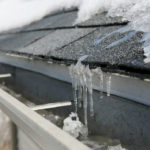Roofing Blog
- Home
- Roofing Blog

What Is Hail & How It’s Formed
Have you ever experienced a sudden downpour of ice pellets from the sky? If you have, then you have witnessed hail – a type of precipitation that can cause serious damage to property and crops. Hailstones can vary in size, from tiny pellets to large chunks that can cause dents in cars and break windows. But how exactly is hail formed?
How Hail is Formed

Hail is a product of thunderstorms, which produce strong updrafts that lift water droplets high into the atmosphere where the temperature drops below freezing. These droplets then freeze and merge with others, forming ice pellets that grow in size as they are carried up and down by the updrafts. Eventually, the hail will become too heavy for the updrafts to lift, and they fall to the ground.
The formation of hail begins with small ice crystals or supercooled water droplets. Supercooled water droplets are water droplets that remain in a liquid state even though the temperature is below freezing. Strong updrafts in a thunderstorm lift these droplets high into the atmosphere. As these droplets are carried higher and higher, they come into contact with colder air and begin to freeze.
As the ice crystals or frozen droplets are carried higher into the thunderstorm, they encounter more water droplets. These water droplets freeze onto the existing ice, creating a layer of ice around the original crystal. The hailstone continues to grow as it travels up and down in the thunderstorm, picking up more layers of ice.
Eventually, the hail will become too heavy for the updrafts to keep it aloft, and it falls to the ground. The size of the hailstone depends on the amount of time it spends in the thunderstorm, the strength of the updrafts, and the availability of water droplets.
The Conditions Necessary for Hail Formation
The formation of hail requires specific atmospheric conditions. Firstly, a thunderstorm must be present. Thunderstorms are characterized by strong updrafts that can carry water droplets high into the atmosphere. Secondly, the temperature in the upper atmosphere must be below freezing, allowing the water droplets to freeze and form ice. Thirdly, there must be a source of moisture in the atmosphere. This moisture can come from warm, moist air rising from the ground.
The strength of the updrafts is also an important factor in hail formation. The stronger the updrafts, the more time the hailstones spend in the thunderstorm and the larger they can grow. If the updrafts are not strong enough, the hailstones will fall to the ground before they have a chance to grow.
The Stages of Hail Formation
The formation of hail can be broken down into three stages: the growth stage, the mature stage, and the decay stage.
During the growth stage, strong updrafts lift small ice crystals or supercooled water droplets high into the atmosphere. As these droplets are carried higher and higher, they freeze and begin to form the core of the hailstone.
During the mature stage, the hailstone continues to grow as it travels up and down in the thunderstorm, picking up more layers of ice. The hailstone can reach up to several inches in diameter during this stage.
During decay, the hailstone begins to fall to the ground as the updrafts weaken. The hailstone may also start to melt as it encounters warmer air on its descent to the ground.
Hail Size and Types
Hail can range in size from small pellets to large chunks that can cause significant damage. The largest hail ever recorded was 8 inches in diameter and weighed 1.9 pounds.
Hailstones can also come in different shapes and types. The most common type of hailstone is the round hailstone, which is formed in thunderstorms with weak updrafts. Another type of hailstone is the jagged hailstone, which is formed in thunderstorms with strong updrafts. Jagged hailstones have a more irregular shape and can be more destructive.
The Dangers of Hail Storms

Hailstorms can be dangerous and destructive. Hail can cause significant damage to property, including cars, homes, and crops. Large hailstones can break windows, dent cars, and damage roofs. Hail can also cause injury or even death to people caught outside during a storm.
In addition to these immediate dangers, hail can have long-term environmental effects. Hail can damage crops, reducing yields and economic losses for farmers. Hail can also cause soil erosion and damage to wildlife habitats.
Hail Damage Prevention and Protection Tips
There are several ways to protect yourself and your property from hail damage. If you are caught outside during a hailstorm, seek shelter immediately. This can include going inside a building or staying in your car if no shelter is available. If you are driving, pull over to the side of the road and cover your face and head with your hands or a blanket.
To protect your property, consider installing impact-resistant windows and doors. These types of windows and doors are designed to withstand the impact of hailstones and other debris. You can also install a hail-resistant roof, which is specifically designed to withstand hail.
Interesting Facts About Hail

- Hailstones can fall at speeds of up to 100 miles per hour.
- Hailstones are not always round. They can come in all shapes, including cones, cylinders, and jagged shapes.
- The largest hail ball ever recorded was 8 inches in diameter and weighed 1.9 pounds.
- Hailstones can cause millions of dollars in damage each year.
Hail Myths and Misconceptions
There are several myths and misconceptions about hail. One common myth is that hail only occurs in the summer months, and in reality, hail can occur any time of the year as long as the atmospheric conditions are right.
Another myth is that hailstones are always white. In reality, hailstones can come in a variety of colors, including black, green, and yellow. The color of the hailstone is determined by the type of debris it picks up as it falls to the ground.
Conclusion
Hail is a fascinating and potentially dangerous weather phenomenon. Understanding how hail is formed and how to protect yourself and your property during a hailstorm can minimize the risks associated with this type of weather event. Remember to seek shelter immediately if you are caught outside during a hailstorm, and consider installing impact-resistant windows and doors and a hail-resistant roof to protect your property.



